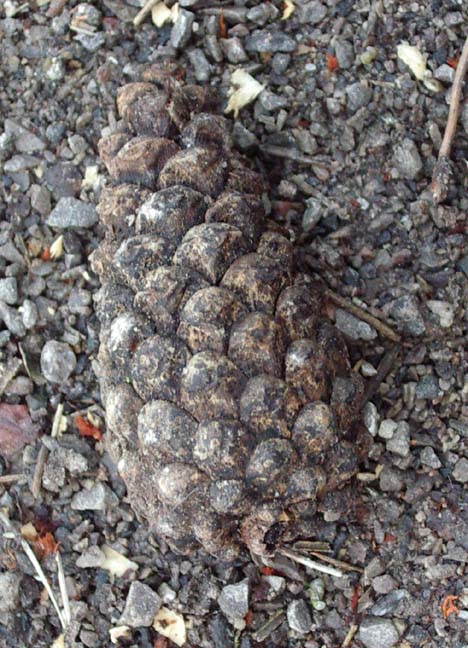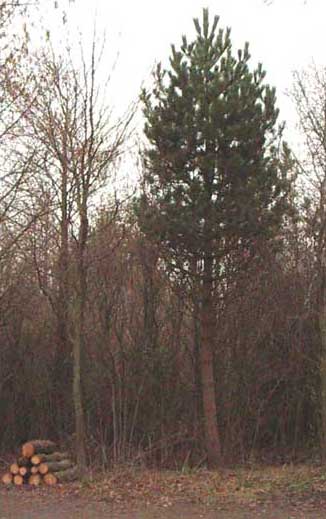| WILDLIFE
REPORTS 2004 et seq.
Unimproved
Chalk Downland
Mill
Hill Homepage (Link)
LINK
TO THE MILL HILL WILDLIFE REPORTS FOR SUMMER & AUTUMN 2004
6 July
2004
About
eight Marbled White Butterflies
were spotted on the upper slopes with a further three on the lower slopes.
This was thought to be only a sample of a more numerous population of these
prominent butterflies that were mating in the area around of and just north
of the reservoir.
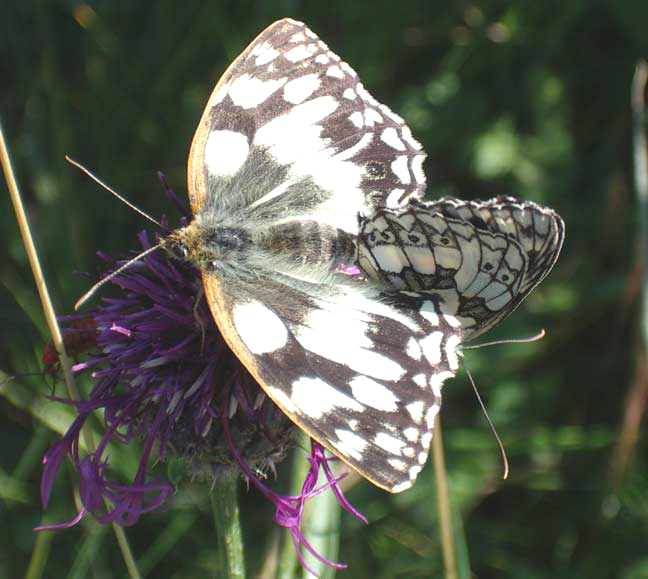
The brown
front edge of the wing shown in the photograph is not usually seen in this
species.
Lower
Slopes Report
A
handful of the first Gatekeeper Butterflies
of 2004 were to be seen in the scrub.
28
June 2004
The
Field
Scabious is the one in flower and I was
able to confirm the species from the leaves. But
the large yellow patches of Bird's Foot
Trefoil were no longer to be seen from
a distance.
At
least two Vestal Cuckoo Bumblebees,
Psithyrus
vestalis, were noted and identified from
the lower slopes of Mill Hill.
Report
from the Shoreham Bank (Lower Slopes)
21
June 2004
Amongst
the long grasses and flowers in the north-east corner of Mill
Hill, my first Large Skipper
of 2004 put in an appearance. I thought it was a Small
Skipper at first, until it opened up its wings.
An earlier probable Small Skipper
near an Elderberry Bush
south-east of the reservoir is not now a definite.
Skipper
ID Page

On the
upper slopes of Mill Hill, there were a handful of Small
Tortoiseshell Butterflies, plus at least
five Meadow Browns,
half a dozen Common Blues,
and a dozen Small Heath Butterflies.
In the scrub there was a single Red Admiral,
in the woods to the north and north-west at least eight Speckled
Woods. On the lower
slopes the Small Heaths
were amorous and were estimated at 30+ with the occasional Meadow
Brown and at least two Common
Blues,
one female and one male. One Cinnabar Moth
flew in the weak sunshine.
Three
dried out fungi (toadstool-like) were discovered
on a dead tree within the scrub.
Other
plants noticed were a large clump of blue
Meadow
Cranesbill,
Geranium pratensis,
(could
be escaped Garden Cranesbills)
on the upper
slopes near the top car park; Perforate
St John's-wort,
Hypericum perforatum, in
glades within the cleared scrub; and Garlic
Mustard, Alliaria
petiolata, in a sheltered spot by the
steps in the north-west corner.
Fungi
Photograph (Link)
Mill
Hill: Summer 2004 More Images

The
Meadow
Crane's-bill in the photograph above is the best choice as the food
plant of the Brown Argus Butterfly.
15
June 2004
Much
to my astonishment, an early (one week early) Marbled
White Butterfly settled on a patch of
grass immediately in front of me on the lower
slopes of Mill Hill (at the northern end as the path leaves the open
into the Hawthorn scrub). A handful of battered Adonis
Blues were
mostly on the lower slopes, and 40+ Small
Heath Butterflies and a handful of Meadow
Browns were on the lower slopes and above
the ridge. A Small Skipper* fluttered
around an Elderberry bush
at the top of the path, where a spider
had caught a Cinnabar Moth and
two
Crane Flies in its web. One large butterfly
was disturbed and flew off with such rapidity that this was notable in
itself: it had a large hint of orange to it and the favourite must be a
Meadow
Brown.
Grasshoppers could be seen and
heard.
(*
Originally there was a possible doubt over the identity: it is now 90%
sure to be a Small Skipper with the profile of the Small Skipper, rather
than a Large Skipper, and a complete absence
of black markings on the underside of the wings. NB:
All the 2005 sightings really indicate that this could only have been a
Large
Skipper.)

|

|
|
Spider's
Web
|
Musk
Thistle
|
In
addition on the footpath approach to Mill Hill from the Waterworks
Road, a handful of Meadow Brown
Butterflies, at least two Small
Tortoiseshell Butterflies, and at least
one Common Blue Butterfly
and one Small Blue Butterfly
were seen.
Adur
First Butterfly Dates 2004
Butterfly
Conservation: First Sightings
Adur
Butterfly List 2004
Thistles
of Adur
Chalk
Downland Insects (David Element)
Under
a almost cloudless blue sky, the air temperature reached 28.8 ºC in
the early afternoon.
13
June 2004
On
a sticky humid day, I was not prepared for a butterfly
I did not recognise: when my eyes focused in and the features revealed
themselves and it looked more like a giant Dingy
Skipper
with clearer markings than any other
species. Alas, the butterfly was elusive just on the upper part of the
slope just down the path from the ridge when arriving from the south. This
area is scrub and long grass. At first I thought this could be a Dark
Green Fritillary, which would be an addition
to the Mill Hill list. The Dog
Violet food plant is within a few metres
of where it was seen. However, on reflection, I think this identification
is unlikely. On further reflection, the possibility is still there. I only
had a brief glance and the lower upper wing is not so brightly patterned
so it is conceivable that it is this species. There has been another possible
sighting of a Dark Green Fritillary and
photographs from Cissbury
Ring lay credence to this identification.
PS:
A subsequent observation has made this out to be a Painted
Lady Butterfly.
Adur
Butterflies
The
yellow patches on the ridge were expanses of Bird's
Foot Trefoil.
Just
north of the reservoir on the upper slopes, a worn (faded but not battered)
Painted
Lady Butterfly was seen as it fluttered
around and settled. On the way to Mill Hill
from the south-west, a Small Blue Butterfly
and a Meadow Brown
were seen on the footpath at the top of the road embankment. Adonis
Blues
were mating down on the lower slopes.
Adur
Butterfly List 2004
11
June 2004
 A
small clump of Spotted Orchids, Dactylorhiza
fuchsii, are recorded on the road
embankment (north-west) side to the south of Mill Hill, where the yellow
patches are Bird's Foot Trefoil
in flower. Eyebright
was in flower on this bank. The lower slopes
recorded mostly
Common Blue
and Small Heath Butterflies. A
small clump of Spotted Orchids, Dactylorhiza
fuchsii, are recorded on the road
embankment (north-west) side to the south of Mill Hill, where the yellow
patches are Bird's Foot Trefoil
in flower. Eyebright
was in flower on this bank. The lower slopes
recorded mostly
Common Blue
and Small Heath Butterflies.
Adur:
Spotted Orchids
Full
Report from the Shoreham Bank (Lower Slopes)
On
the road embankment by Chanctonbury Drive (SE of the bridge) the dozen
or so Small Blues were
seen immediately with a Painted Lady Butterfly,
which was past pristine condition without being faded or battered. In Chanctonbury
Drive over the grass a Red Admiral Butterfly
fluttered by.
Adur
Butterfly List 2004
10
June 2004
On
the town side of the bridge leading to Mill
Hill that transverses the main A27
road, on the east there is a small Hawthorn copse (at the top of
Chanctonbury drive, north side) leading to the grasses of the trunk road
steep bank. In this small garden sized plot of long grasses and scrub,
between 30 and 50 was my estimate of the number of Small
Blue Butterflies. At least a dozen of
these were seen all at one time, including at least two pairs mating, but
its was difficult to work out their numbers because it was in the afternoon
and they hid down in the long grasses most of the time.
 |

|
This
constitutes the first positive record of this butterfly for Mill Hill,
which makes the number of butterflies as
26 definites. If these numbers are repeated all along the road embankment,
the colony must number several hundred. A female Common
Blue Butterfly looked much larger in comparison
to the smallest of the British blues and the Speckled
Wood Butterfly that arrived was larger
still.
Mill
Hill Butterfly List
6 June
2004
The
first positive Wall Brown Butterfly
of the year in the lower Adur valley was seen on the path between the Waterworks
Road (Old Shoreham) and Mill Hill (south of the A27
Shoreham by-pass). It flew strongly and it
was tricky to confirm the identification (this butterfly may be under recorded)
and even more tricky to photograph. The Wall
Brown Butterfly was seen on and over the bridleway
path running west to east and next to the road embankment.
A
small white butterfly was flying strongly over the southern part of the
upper slopes of Mill Hill. This was definitely
identified as a Green-veined White Butterfly
which increases the confirmed New Millennium Mill
Hill butterfly list at 25 plus two probables.

|

|
Wall
Brown Butterfly
Very
often this butterfly will land on paths and walls
|
Adonis
Blue Butterflies
mating
|
Down
on the lower slopes of Mill Hill, the Horseshoe
Vetch had ceased its main flowering and could
be seen on the ground, but the spectacular bloom of a fortnight before
that could be seen from half a mile away had now receded to a green expanse.
Blue butterflies were immediately noticeable. On the normal transect travelling
the distance of the path to the copse and back, 28
Adonis
Blue Butterflies were counted as positive
single butterfly sightings (24 males,
3
females and
one
indeterminate) with only one Dingy
Skipper settling although there could
have been more. All three definite Adonis
females were the conventional chocolate brown
colour. The midday visit also yielded an estimated 50
Small
Heath Butterflies.
Adur
Butterfly List 2004
Adur
Butterflies Flight Times
Adur
First Butterfly Dates 2004
25
May 2004
 On
the top ridge of Mill Hill the turf is full of Creeping
Cinquefoil* and buttercups
and this may have led me to miss the patches of Horseshoe
Vetch above the ridge on the steeper bits
because the yellow plants merge into one another and it was only by walking
over the incline that can I see the ground flora of the salt-blasted grass
turf exposed to the south- westerlies. This is the area where model aircraft
are launched into the wind. There was one male
Adonis
Blue Butterfly that caught my eye. There
were just another seven of these bright blue butterflies to be seen on
the lower slopes. (*
The precise species is under enquiry.) On
the top ridge of Mill Hill the turf is full of Creeping
Cinquefoil* and buttercups
and this may have led me to miss the patches of Horseshoe
Vetch above the ridge on the steeper bits
because the yellow plants merge into one another and it was only by walking
over the incline that can I see the ground flora of the salt-blasted grass
turf exposed to the south- westerlies. This is the area where model aircraft
are launched into the wind. There was one male
Adonis
Blue Butterfly that caught my eye. There
were just another seven of these bright blue butterflies to be seen on
the lower slopes. (*
The precise species is under enquiry.)
23
May 2004
 The
blooming of the Horseshoe Vetch
was even more impressive on the lower slopes
than last year after the recent rain, but there were the first signs that
the flowers are beginning to diminish. Of the 19
Adonis
Blue Butterflies, just one was a brown
female with a lot of blue on its upper wings
and body. Small Heath Butterflies,
Dingy
and Grizzled Skippers
were there as well as would be expected at this time of the year. The
blooming of the Horseshoe Vetch
was even more impressive on the lower slopes
than last year after the recent rain, but there were the first signs that
the flowers are beginning to diminish. Of the 19
Adonis
Blue Butterflies, just one was a brown
female with a lot of blue on its upper wings
and body. Small Heath Butterflies,
Dingy
and Grizzled Skippers
were there as well as would be expected at this time of the year.
Full
Report
17
May 2004
The
first Adonis Blue Butterfly
for Mill Hill was seen on the upper slopes with a Small
Tortoiseshell Butterfly south of the reservoir
near where the old stile was and by the Elderberry
bush and the red dog bin.

The
lower
slopes were spectacularly blooming with
Horseshoe
Vetch in their annual May display where
a further Adonis Blue Butterfly
was seen at the northern end. (The yellow in the northern lower agricultural
field are buttercups and related plants.)

Horseshoe
Vetch
There
appeared to be at least one Hairy Violet,
Viola
hirta, with blunt sepals and hairy leaves
on the lower slopes of Mill Hill.
Violets
of Mill Hill
13
May 2004
The
Horseshoe
Vetch is now flowering over almost its
complete range on the lower slopes of Mill
Hill, including the southern end of the steeper slopes that was not showing
at all a week ago and could not be seen from a distance three days ago.
Almost all the Dog Violets
on the open chalk face had diminished and the blue and pink was that of
the Common Milkwort, Polygala
vulgaris.
The
only butterflies on the lower
slopes of Mill Hill were Dingy Skippers
(12),
Small
Heath (1),
Small
White (1) and
Peacock
(1).
There was a Pyrausta
nigrata moth and one Wave
Moth, Cabera sp.
10
May 2004
East
of Mill Hill, the first Rook
appeared, followed by a pair east of Erringham Hill, and at Anchor
Bottom and Beeding Hill to the north over 300
Rooks probed in the grasslands.

|
Mushrooms
amongst the grass south of the Reservoir
These
are probably a species of Agrocybe.
ID
suggestion by
Malcolm
Storey (BioImages) |
A handful
of Agaric mushrooms
showed their caps on long thin stalks above the grass and herbs south of
the reservoir on the upper slopes.
NB:
Agrocybe
dura is found on chalk grasslands.
Fungi
of the Downs in May 2004
In
the scrub in the north-west of Mill
Hill Nature Reserve there were a handful of Brimstone
Butterflies and at least one Speckled
Wood Butterfly.
Field
Mouse-ear flowered in small clumps in
the central area christened the Triangle.
5
May 2004
Adur
District Council Meeting
Mill
Hill, Lancing Ring (West Sussex) Management Plans
Community
Services Committee
The
unanimous decision of the Committee was to refer the application to the
Scrutiny Committee for a more detailed look at the facts (which are in
dispute).
Smart
Groups ADUR VALLEY EFORUM for discussion and further information
Message
Link
2 May
2004
My
first Small Heath Butterfly,
the first of just three, were amongst a handful of Dingy
Skippers and a Brimstone
Butterfly on the lower
slopes of Mill Hill.
26
April 2004
 As
the first Horseshoe Vetch
and Milkwort
were beginning to flower on the lower slopes
of Mill Hill, I observed the first skipper butterflies of the year. An
amorous pair of Grizzled Skippers
danced around the bramble borders, with at least one Dingy
Skipper and two or more Brimstone
Butterflies. The day flying micromoth
Pyrausta
nigrata could conceivably be mistaken
for the Grizzled Skipper.
This moth is slightly more prevalent of the two. In the scrub in the north-west
of Mill Hill there were two Speckled
Wood Butterflies and a single Peacock
Butterfly. On the open upper
slopes there was another Brimstone
and a handful of Small Tortoiseshells,
orange in colour but not fresh, the orange dulled by age. As
the first Horseshoe Vetch
and Milkwort
were beginning to flower on the lower slopes
of Mill Hill, I observed the first skipper butterflies of the year. An
amorous pair of Grizzled Skippers
danced around the bramble borders, with at least one Dingy
Skipper and two or more Brimstone
Butterflies. The day flying micromoth
Pyrausta
nigrata could conceivably be mistaken
for the Grizzled Skipper.
This moth is slightly more prevalent of the two. In the scrub in the north-west
of Mill Hill there were two Speckled
Wood Butterflies and a single Peacock
Butterfly. On the open upper
slopes there was another Brimstone
and a handful of Small Tortoiseshells,
orange in colour but not fresh, the orange dulled by age.
Adur
Butterflies Flight Times
Adur
Butterflies
On
the upper
slopes of Mill Hill the Morels
were dried out and at least one of two toadstools appeared to be eaten
so that a hole appeared (they are hollow inside). The
Common
Carder Bee, Bombus
pascuorum, with is orange furry thorax
was buzzing around the grass at the southern end, near the Blackthorn
bushes on the east side midway between the car park and the reservoir.
Fungi
of Shoreham
Adur
Bumblebees
Mill
Hill Nature Reserve
20
April 2004
 It
was the long probing beak on the short turf of a Rook
on the top of Mill Hill that gave it away. Its grey face was apparent
even before I fastened my binoculars on this solitary corvid. Only about
one in a thousand large black corvids locally are Rooks,
the rest are Crows
with Jackdaws
classed as small. It
was the long probing beak on the short turf of a Rook
on the top of Mill Hill that gave it away. Its grey face was apparent
even before I fastened my binoculars on this solitary corvid. Only about
one in a thousand large black corvids locally are Rooks,
the rest are Crows
with Jackdaws
classed as small.
A
solitary toadstool was amongst the still short grass near a Hawthorn bush.
I recognised it immediately as a Morel,
Morchella
esculenta, because of its unusual distinctive
appearance. I had not seen one before and although an edible species, I
left it in its place just south of the car park.
The
male
Kestrel
hovered
over the lower slopes, whereas the female
was seen at a much lower trajectory flying over the outskirts of the copse.
Adur
Fungi: Fruiting Times
Fungi
of Shoreham
A further
check on the violets
of Mill Hill revealed that the violets
on the upper slopes (the Triangle) and the
scrub
in the north-west were all Sweet Violets,
and the violets
on the lower slopes were almost all Dog
Violets.
Violets
of Mill Hill
 15
April 2004 15
April 2004
A
Common
Lizard, Zootoca
vivipara, skittered across the footpath
just south-west of the bridge over the A27 on the route
to Mill Hill. Dog
Violets were showing better on the
lower
slopes, with
Red Campion, Daffodils
and
Bluebells
in flower above the ridge on the upper
slopes. A Kestrel
hovered over the ridge and it dived, wings pinned close to its body for
an impressive display. Lackey Moth caterpillars
clambered over a Hawthorn, and it is these caterpillars that weave the
white tent or cocoon (pic).
Violets
of Mill Hill
9 April
2004

The
splendidly coloured Emperor Moth,
Pavonia
pavonia, rested among the grasses at the top of the lower
slopes of Mill Hill. It was discovered by Katherine
Hamblett and Tacita French. The feeding plants
for the caterpillars varies according to location: it could be Bramble,
Hawthorn, Elder or Creeping Cinquefoil.
Lancing
Nature
7 April
2004
A
young Roe Deer
is found dead on the side of the road near the upper car park at Mill Hill.
Report
by Mick Bowen
 26
March 2004 26
March 2004
Sweet
Violets in purple are scattered with hundreds
of plants over the sheltered bits of Mill Hill, most of them violet
in colour but in the Triangle area of the middle
slopes all white flowered plants were present. This is a very common
wild flower. On the lower slopes the hundreds
of plants have little or rudimentary leaves and I am not sure if these
were the same species.
Violets
of Mill Hill
22
March 2004
The
Sweet
Violets (pic)
at the top of the wooded slopes on the southern section of Mill Hill looked
battered by the gales and hail of the last two days. The Buff-tailed
Bumblebee, Bombus
terrestris, was the species present,
a solitary one observed, and this is the commonest and most noticeable
local species.
British
Bumblebee Checklist
 2
March 2004 2
March 2004
After
reports of Buzzards over
Thundersbarrow
I thought a quick visit to Mill Hill could prove interesting. A couple
of Kestrels
were performing acrobatics on the thermals and they both looked like the
more colourful male of this raptor species. A few Lapwings
wheeled overhead but the large flocks were over the grazing fields to the
east.
16
February 2004
Well
over five hundred Black-headed Gulls
filled the sky over the pasture land dip between Mill and Buckingham Barn
to the east.
Tree
felling has opened up a glade to sunlight in the copse
on Mill Hill, next to the fence adjoining the arable field, which is
Erringham Hill, (see the notes for 9
February 2004).
9
February 2004
 It
would have come as a bit of a shock to me if I had not already received
a handful of local reports of Painted Lady
Butterflies. A flutter of orange and the
unmistakable patterns (now that I can recognise them instantly: to novices
they could resemble a Small Tortoiseshell
Butterfly) of a Painted
Lady Butterfly that flew steadily over the
southern section of Mill Hill. Later, a second Painted
Lady flew around the copse
and settled on the Beech
leaves still on the tree and several times on the grass. I now think these
are possibly immigrant butterflies
rather than hibernating adults that have awoken. I am still undecided though. It
would have come as a bit of a shock to me if I had not already received
a handful of local reports of Painted Lady
Butterflies. A flutter of orange and the
unmistakable patterns (now that I can recognise them instantly: to novices
they could resemble a Small Tortoiseshell
Butterfly) of a Painted
Lady Butterfly that flew steadily over the
southern section of Mill Hill. Later, a second Painted
Lady flew around the copse
and settled on the Beech
leaves still on the tree and several times on the grass. I now think these
are possibly immigrant butterflies
rather than hibernating adults that have awoken. I am still undecided though.
Adur
Butterflies
Adur
Butterfly Flight Times
Other
Reports of Painted Ladies (Adur Nature Notes: February 2004)
Strong
evidence for Immigration of Painted Ladies
A Robin
Redbreast seemed to be just starting to
build a nest in a Hawthorn bush. Another Hawthorn bush was shelter for
a small brown speckled bird
that I could not positively identify.
 The
conservation workers had cleared areas of Dogwood
and other scrub in the prime viewing areas on middle slopes, west of and
down the gentle slope from the upper car park. The plaque for the Mill
Hill Access Trail has now been erected. It looks quite smart and tasteful,
even if superfluous. The
conservation workers had cleared areas of Dogwood
and other scrub in the prime viewing areas on middle slopes, west of and
down the gentle slope from the upper car park. The plaque for the Mill
Hill Access Trail has now been erected. It looks quite smart and tasteful,
even if superfluous.
Bracket
fungi
was already growing on some of the stumps. A Stonechat
warbled away from a dense leafless thicket south-east of the road bridge
over the A27 on the Shoreham town side.
Stonechat
Report

|

|
Early
flowering wild flower
near
the car park
Common
Field Speedwell
Veronica
persica
|
Bracket
fungi
|
21
January 2004
The
grazed pastures to the north-west of Mill Hill
Nature Reserve looked a verdant green compared to the still parched
lower
slopes of Mill Hill.
7 January
2004
Incongruously
on a loose twig, a few bodies of the Jew's
Ear Fungus, Hirneola
auricola-judae, were discovered amongst
the mosses underneath the Hawthorn scrub. Incongruous, because none
of the living trees nearby were hosts to this fungus. An old bird's nest
with a moss base was visible high up in the Hawthorn.
In
the copse at the top of Mill Hill, the
workmen had sawn down some of the pine trees and made a small fire. I think
these were the Corsican Pines,
Pinus
nigra var. maritima.
History
of Mill Hill
There
were at least ten Magpies
in the field between Mill Hill Nature Reserve and Old Erringham Farm and
a flock of over a dozen Goldfinches
near the flint outbuildings.
Link
to the Mill Hill WILDLIFE REPORTS up to 2003
with
lots of Butterfly observations
Lower
Slopes (with Butterfly Reports)

EMail
Address for sending in wildlife reports from the lower Adur valley
Only
a selection will be included and only reports with the name of the reporter
Mill
Hill Nature Reserve (including map)
MultiMap
Aerial Photograph of Mill Hill
Back
to Mill Hill
Triangle
Upper
Slopes
Middle
Slopes
Lower
Slopes
Grasses
of Mill Hill
Mill
Hill Copse
History
of Mill Hill
Aerial
Map
Lower
Adur Levels (MultiMap) including Lancing Clump and Mill Hill
Hippocrepis
comosa (Horseshoe Vetch)
|
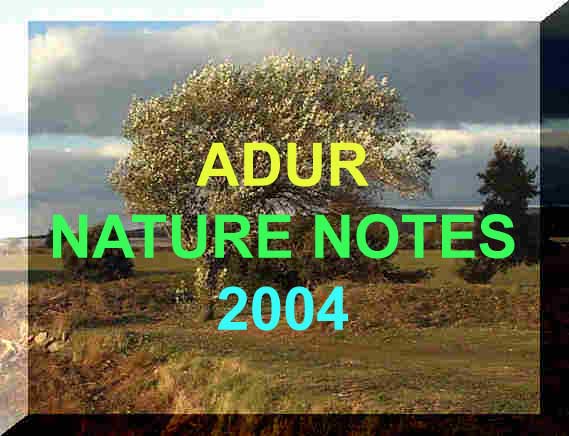
 26
March 2004
26
March 2004

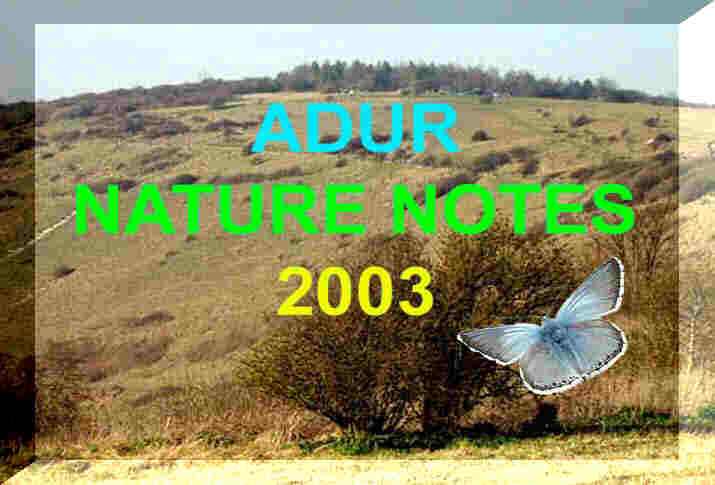














 A
small clump of Spotted Orchids,
A
small clump of Spotted Orchids, 

















 The
conservation workers had cleared areas of Dogwood
and other scrub in the prime viewing areas on middle slopes, west of and
down the gentle slope from the upper car park. The plaque for the Mill
Hill Access Trail has now been erected. It looks quite smart and tasteful,
even if superfluous.
The
conservation workers had cleared areas of Dogwood
and other scrub in the prime viewing areas on middle slopes, west of and
down the gentle slope from the upper car park. The plaque for the Mill
Hill Access Trail has now been erected. It looks quite smart and tasteful,
even if superfluous.



